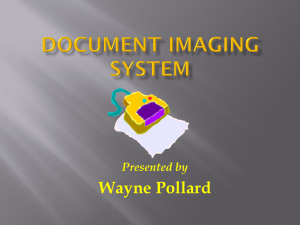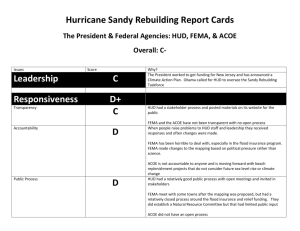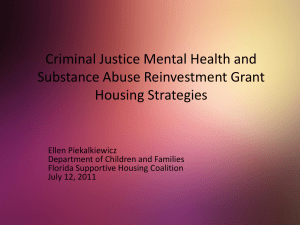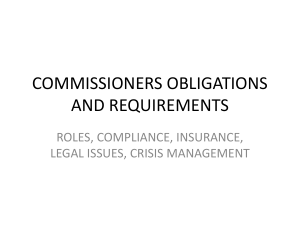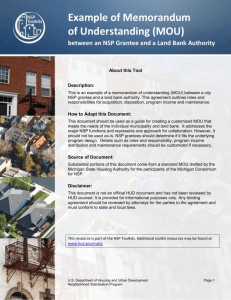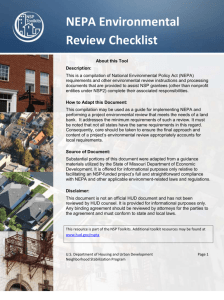Site Specific Environmental Checklist
advertisement
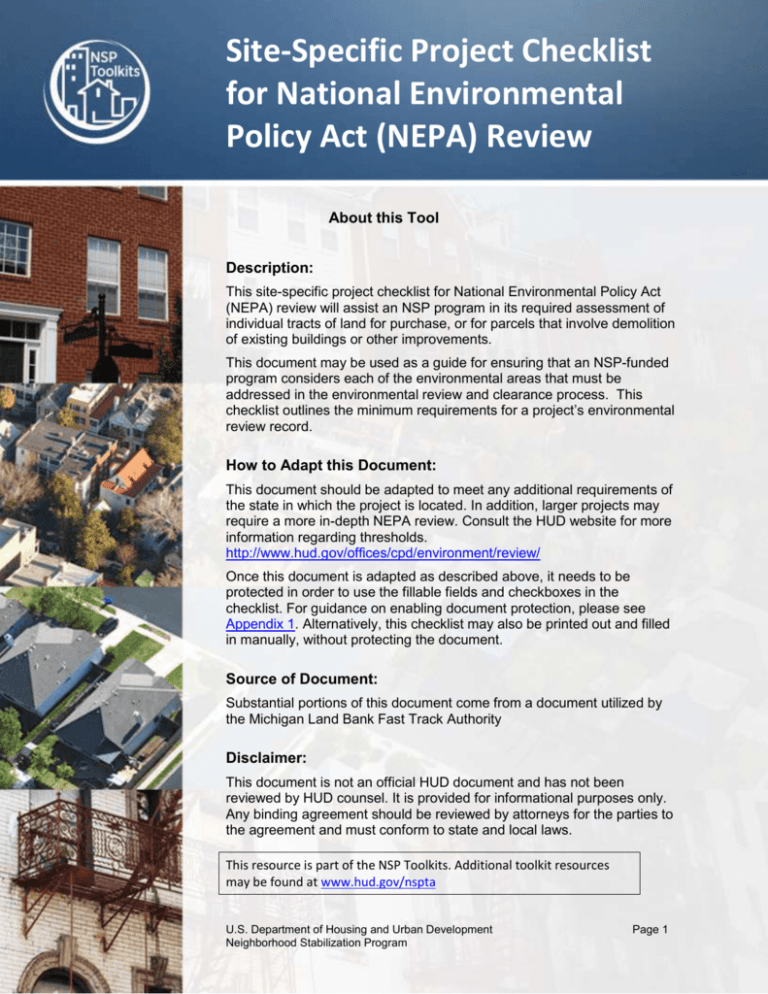
Site-Specific Project Checklist for National Environmental Policy Act (NEPA) Review About this Tool Description: This site-specific project checklist for National Environmental Policy Act (NEPA) review will assist an NSP program in its required assessment of individual tracts of land for purchase, or for parcels that involve demolition of existing buildings or other improvements. This document may be used as a guide for ensuring that an NSP-funded program considers each of the environmental areas that must be addressed in the environmental review and clearance process. This checklist outlines the minimum requirements for a project’s environmental review record. How to Adapt this Document: This document should be adapted to meet any additional requirements of the state in which the project is located. In addition, larger projects may require a more in-depth NEPA review. Consult the HUD website for more information regarding thresholds. http://www.hud.gov/offices/cpd/environment/review/ Once this document is adapted as described above, it needs to be protected in order to use the fillable fields and checkboxes in the checklist. For guidance on enabling document protection, please see Appendix 1. Alternatively, this checklist may also be printed out and filled in manually, without protecting the document. Source of Document: Substantial portions of this document come from a document utilized by the Michigan Land Bank Fast Track Authority Disclaimer: This document is not an official HUD document and has not been reviewed by HUD counsel. It is provided for informational purposes only. Any binding agreement should be reviewed by attorneys for the parties to the agreement and must conform to state and local laws. This resource is part of the NSP Toolkits. Additional toolkit resources may be found at www.hud.gov/nspta U.S. Department of Housing and Urban Development Neighborhood Stabilization Program Page 1 Project Checklist for XXXXX NSP Consortium Program Sites (This form is to be used ONLY for NSP projects funded through the XXXXX NSP Program. Completion of this sitespecific clearance constitutes Phase II of the NSP Environmental Assessment. All questions on the original Statutory Checklist and Environmental Assessment Checklist that needed a site-specific review are listed here.) Consortium Partner: Project Address: Project Activity (check all that apply): Demolition Grant #: Acquisition Rehabilitation Homebuyer If all the answers to the following questions are no, then this project is cleared from further environmental action. However, if you answer yes to any of the following, additional compliance requirements must be met and actions documented. Attach comments and rationale for actions taken and letters, permits, or other documentation signed by the regulating agency to show compliance requirements have been met. Contact your CD Specialist if you have questions. Do not commit any funds to this project until all environmental procedures are completed and documented. Yes 1. Does the project affect a property 50 years or older, demolition, or new Construction ? If “yes”, the State Historic Preservation Officer (SHPO) must be consulted. Date of SHPO response: 2. Is any part of the property within a 100 year flood plain? Record the FEMA Insurance Rate Map panel #: ; and date of panel: If yes, Compliance with Part 55 is required. Community must participate in FEMA’s National Flood Insurance Program and owner must purchase flood insurance. 3. Is the project located within a Coastal Zone Management Area (CMZA) Attach the XXXXX CZM map with project site noted. 4. Is the project located within a “nonattainment” area designated pursuant to the National Ambient Air Quality Standards. Is NESHAP reporting required? If yes, attach documentation of compliance. 5. Is the project located within 1,000 feet of a busy road or highway, 3,000 feet of a railroad, or 15 miles of a FAA-regulated civilian airport or military airfield? If yes, Noise Assessment must be conducted. 6. Is the property located within 2,500 feet of the end of a FAA-regulated civilian airport runway or 15,000 feet of the end of a military airfield? 7. Have any hazardous or toxic materials been used or stored on or near the site? No 8. Is the project located near hazardous industrial operations handling, processing or manufacturing substances of fire-prone or explosive nature? Is it near any known above-ground storage facility that contains more than 100 gallons and is within one mile? 9. Wetlands (If project is in a wetland, the HUD 8-Step Decision Making Process applies.) 10. Endangered species – Does the project area includes threatened and endangered plants and animals, or their habitats? 11. Sole source aquifers- Is there adequate supply to serve project, does the project impact water bodies or wells? 12. Wild/scenic rivers Project impacts to designated rivers & river segments; Does the project impact designated rivers or river segments? 13. Asbestos contamination-Will there be asbestos contamination by the project? 14. Farmland preservation- Does project convert prime or unique farmland to other uses? 15. Environmental Justice- Are there disproportionately high adverse impacts to low income & minority persons? Signature/Preparer Name: Date Instructions for Completing Site-Specific Review 1. State Historic Preservation Office. In addition to structures that are 50-years and older, SHPO reviews demolition and new construction sites. See: http://mishporehab.wordpress.com/ for Guidelines for Consulting with SHPO, HUD/SHPO Memo, September 2002. 2. Floodplain Management. Projects located within a floodplain: 1) are subject to Executive Order 11988 (Floodplain Management) and HUD's implementing regulations at 24 CFR Part 55-Floodplain Management; 2) the community must participate in FEMA’s National Flood Insurance Program and 3) the property owner must maintain flood insurance. See: http://www.hud.gov/offices/cpd/environment/review/floodplain.cfm Note: Financial assistance for minor repairs or improvements on one- to four-family properties that do not meet the thresholds for ``substantial improvement'' are not subject to EO 11988 or Part 55 (See: Sec. 55.12). Substantial improvement means any repair, reconstruction, modernization or improvement of a structure, the cost of which equals or exceeds 50 percent of the market value of the structure before rehab (See: Sec. 55.2(b)(8)). Documentation of Part 55 process, FEMA participation and flood insurance premium required. See: FEMA’s Mandatory Purchase of Flood Ins Guidelines: http://www.fema.gov/library/viewRecord.do?id=2954. 3. Coastal Zone Management (CZM). Berrien and Wayne counties have designated coastal zones. For projects in a coastal zone, grantee must provide XXXX with a finding made by the State CZM agency that the proposed project is consistent with the approved State Coastal Zone Management Program. See DEQ’s site for maps: http://www.XXXXX.gov/deq/0,1607,7-135-3313_3677_369690802--,00.html. 4. Clean Air Act. Maps showing “non-attainment” or “maintenance” areas for air pollutants are found through the EPA or DEQ. Search for “XXXXX NAAQS Attainment Status.” Regardless of any area’s attainment status, no NSP are sources of these pollutants, and all partners can safely answer “NO.” Asbestos: DEQ’s NESHAP requirements for asbestos do not apply to residential activities unless there is a demolition “program” that involves a number of units that, taken together, may impact the environment. All consortium partners with demolition programs must contact the XXXXX NESHAP Program for asbestos reporting requirements: http://www.XXXXX.gov/deq/0,1607,7-1353310_4106-11856--,00.html 5. Use HUD’s Noise Abatement and Control Checklist. 6. Runway Clear Zones (RCZ) – civil airports; Clear Zones and Accident Potential Zones -- military airfields. Selfridge Air National Guard Base is the only military base in XXXXX. See attached list of Civil Airports. In RCZ/CZ: new construction, major rehabilitation (cost = 75% after rehab value), and activities that significantly prolong physical or economic life of the property are prohibited. In APZ: HUD assistance is discouraged and project must be compatible with US Dept Of Defense land use guidelines for APZs. Maps are available from airport operations authorities. The Airport Layout Plan shows Runway clear Zones at civil airports. The Air Installation Compatible Use Zone (AICUZ) Study shows the CZ and APZ for military bases. If answer is yes, follow process for compliance given in HUD’s Fact Sheet #D1: Siting HUDAssisted Projects (attached). http://www.hud.gov/offices/cpd/environment/review/airport.cfm. 7. Contamination/Toxic Substances. Particular attention to be given to any site located on or in general proximity to landfills, dumps, industrial sites, gas stations, or other locations that contain hazardous wastes or materials. Phase I Environmental will probably be required. Grantee must contact Bruce Jeffries, MSHDA’s Certifying Officer at 517-335-0183 or jeffriesb@XXXXX.gov. 8. Explosive and Flammable Hazards. If yes, calculate the acceptable separation distance per guidebook (HUD-1060-CPD), “Siting of HUD-Assisted Projects Near Hazardous Facilities” and apply appropriate mitigation measures or reject the site. (http://www.hud.gov/offices/cpd/environment/training/guidebooks/hazfacilities/) 9. Wetlands. If yes, attach a color wetland map with the project site clearly marked. Ensure the map is zoomed in close enough to exhibit details of the surrounding project area http://www.fws.gov/wetlands/Data/mapper.html - FWS Wetlands Mapper (National Wetlands Inventory) 10. Endangered species. If Yes, 1) Explain agency requirements 2) Explain if they are feasible in relation to project goals 3) Describe the mitigation plan to address requirements and if mitigation measures are required for completion prior to beginning any physical activity, etc http://www.fws.gov/endangered/ESA/content.html - Endangered Species Act of 1973 11. Sole source aquifers. If yes, Print and attach supporting documentation. EPA-designated sole source aquifers are listed at: http://www.epa.gov/safewater/sourcewater/pubs/qrg_ssamap_reg7.pdf 12. Wild/Scenic Rivers. If Yes, with potential for adverse impacts, contact the following and attach all related documentation http://www.nature.nps.gov/water/Wild_Scenic_Rivers/index.cfm - Wild & Scenic Rivers Act http://www.access.gpo.gov/nara/cfr/waisidx_00/36cfr297_00.html -Wild & Scenic Rivers Act, 36 CFR Part 297 13. Asbestos Contamination. Acceptable documentation: current historical property data, site inspections, ASTM E1527-05 Standard Phase I Environmental Site Assessment and, if applicable, Phase II and Phase III Assessments, other recent environmental studies, documentation from DNR and EPA staff. 14. Farmland Preservation. If yes, complete the Farmland Conversion Impact Rating Form AD 1006 at the following: http://www.nrcs.usda.gov/programs/fppa/pdf_files/AD1006.PDF. Submit the form to the USDA NRCS office in your region. Contact information for NRCS offices at the following website: http://offices.sc.egov.usda.gov/locator/app?agency=nrcs 15. Environmental Justice. Determine & explain what currently exists in the area by accessing EPA’s Environmental Justice Geographic Assessment Tool at- http://www.epa.gov/enviro/ej/ (Username - ejuser1 & Password - UserPass000). Appendix 1: Instructions for enabling document protection in order to utilize electronic fields and text boxes You must enable document protection before you can use the fillable fields and checkboxes in this checklist. When these protections are enabled, the rest of the document will not be editable. In Word 2007 1. Click the round Office button on the top left-hand corner of the menu 2. Click on the “Word Options” button at the bottom of the dropdown 3. The “Popular” menu item should be selected by default. In this menu, click on the third checkbox down -- next to “Show Developer Tab” 4. Click OK. 5. The “Developer” ribbon should now display as the last tab on the ribbon menu. Click on it. 6. Click the “Protect Document” button and click on “Restrict Formatting and Editing” in the dropdown. A menu will appear in the right panel of Word. 7. Click the checkbox next to “Allow only this type of editing in the document” 8. Select “Filling in Forms” from the dropdown below the checkbox. 9. Click on “Yes, Start Enforcing Protection.” If this button is greyed out, you are probably in design mode and you will need to exit design mode before you can click the box. 10. A popup box will appear. Click OK. As long as you don’t enter a password, no password protection will be applied. In Word 2003 1. Click on Tools in the top menu bar. 2. Click on “Protect Document” in the dropdown. 3. A popup box will appear. Follow steps 7 through 10 above.


